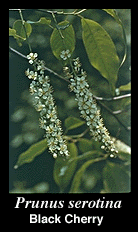
Known As: Cabinet-Cherry, Black Choke, Rum Cherry, Virginian
Prune-Bark, Whisky-Cherry, Wild Cherry, Wild Black Cherry.
Latin Name: Prunus serotina
Description: Can grow as a tree or a shrub up to 90 feet high.
Bark on young branches and twigs is scaly and reddish-brown with prominent
cross-marks; bark on older branches and straight trunk is rough and black.
Leathery leaves are alternate, simple, elliptic-pointed and finely toothed
on the edges. Showy, fragrant white flowers hang in drooping clusters
and produce dark-red to purply-black cherry fruit about the size of a pea.
Poisonous Parts: All parts are potentially toxic but damaged
leaves are the greatest risk. Contains prunasin which is a cyogenic
precursor that releases cyanide when damaged.
Symptoms: Anxiety, breathing problems, staggering, collapse,
sudden death. May produce vomiting, abdominal pain, and in some cases diarrhea.
Treatment: Contact a veterinarian and
rush your pet to them immediately. Antidote needs to be given intravenously
within a few minutes of the onset of the signs. Do not handle or
stress affected animals more than necessary as this will worsen the signs.

Images courtesy of Ohio Forestry Service.

